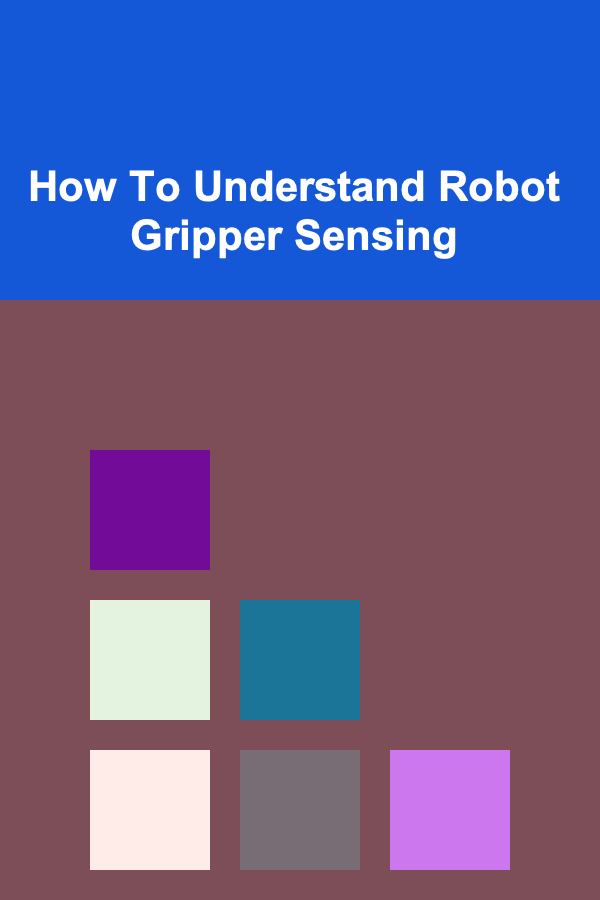
How To Understand Robot Gripper Sensing
ebook include PDF & Audio bundle (Micro Guide)
$12.99$7.99
Limited Time Offer! Order within the next:

In the world of robotics, precision, adaptability, and efficiency are paramount, especially when it comes to tasks that involve manipulation and interaction with the environment. A crucial component in enabling robots to handle objects with care and accuracy is the robot gripper . These end-effectors, which serve as the "hands" of robots, rely heavily on sensing technology to enable them to understand their environment, grasp objects effectively, and make decisions based on real-time feedback.
Robot gripper sensing, at its core, involves the integration of various sensors that allow a robot to detect physical properties like force, pressure, texture, and even temperature, thereby improving the robot's ability to handle and manipulate objects in a safe and efficient manner. In this article, we will explore the technology behind robot gripper sensing, its various types, applications, challenges, and future trends.
The Role of Robot Grippers in Robotics
Before delving into the specifics of sensing technologies, it is important to first understand the role of robot grippers in robotics. A robot gripper functions as the robotic equivalent of a human hand, used to grasp, hold, or manipulate objects. Depending on the task at hand, robot grippers can vary in design, size, and actuation mechanisms, but their core function remains the same: providing the robot with the ability to interact with its surroundings by physically interacting with objects.
The importance of robot grippers lies in their ability to perform tasks that require dexterity and precision, from assembling small parts to picking up fragile items. Grippers are crucial components in fields like:
- Manufacturing: For tasks like assembly, packaging, and material handling.
- Healthcare: In surgeries and rehabilitation devices, where precision is critical.
- Agriculture: For harvesting crops or sorting produce with care.
- Service and Logistics: In tasks involving product picking, sorting, and delivery.
The efficiency and accuracy of a robot gripper are highly dependent on its sensing capabilities. Without sensors, a gripper would simply open and close, without understanding its interaction with the environment or its actions' impact on objects.
Understanding Robot Gripper Sensing
Robot gripper sensing involves using sensors embedded within or around the gripper to measure various physical properties. These sensors provide feedback to the robot, allowing it to adjust its actions in real-time. The data obtained from these sensors helps the robot understand the object it is interacting with, such as its size, weight, shape, and texture. Furthermore, sensing plays a key role in preventing damage to delicate objects, ensuring that the robot applies just the right amount of force during manipulation.
There are several types of sensors commonly used in robot grippers, each serving a unique function. These sensors can be broadly categorized into force/torque sensors , position sensors , proximity sensors , vision sensors , and touch sensors.
1. Force/Torque Sensors
Force and torque sensors are integral to gripper sensing, as they allow robots to gauge the amount of force they are applying while grasping an object. Force sensors measure the magnitude of force exerted on an object, while torque sensors detect rotational forces or moments.
Force sensing helps robots determine if they are gripping an object too tightly or too loosely. For instance, if a robot's gripper detects an excessive force applied to a fragile object, it can adjust its grip to prevent damage. Similarly, a gripper can ensure that it is holding an object securely by detecting if the force applied is too weak, thereby avoiding slippage.
These sensors are typically based on piezoelectric materials or strain gauges. Piezoelectric sensors generate a voltage in response to mechanical stress, while strain gauges measure the deformation of a material under stress.
2. Position Sensors
Position sensors are used to track the position of the gripper's fingers or jaws. These sensors are essential for ensuring that the gripper moves in a precise manner and for determining the orientation of the object being manipulated.
By providing feedback on the position of the gripper's components, position sensors help the robot maintain proper alignment with the object it is grasping. For instance, if the gripper is misaligned, the position sensor can notify the robot to adjust its movement to properly grip the object.
Common types of position sensors include encoders , which track rotational movements, and linear variable differential transformers (LVDTs), which measure the linear displacement of the gripper components.
3. Proximity Sensors
Proximity sensors are essential for detecting the presence of an object without making direct contact. These sensors can help the robot locate objects before actually gripping them. This is particularly useful in automated environments where objects may be scattered or when an object needs to be picked up from a specific location.
Common types of proximity sensors include capacitive , inductive , and ultrasonic sensors. Capacitive sensors detect changes in the electric field when an object comes close, while inductive sensors are sensitive to metallic objects. Ultrasonic sensors use sound waves to measure distance and detect the presence of objects.
4. Vision Sensors
Vision sensors, such as cameras and machine vision systems, play a crucial role in gripper sensing. These sensors enable robots to "see" and interpret the environment. In the context of gripper sensing, vision systems are used for object recognition, orientation detection, and tracking.
With vision sensors, robots can determine the exact shape, size, and orientation of objects, which is particularly useful when manipulating items with complex geometries. Vision-based systems can also detect color and texture, which can help the robot adjust its grasp according to the object's characteristics.
Vision sensors are typically combined with image processing algorithms and machine learning models to improve their accuracy and adaptability. By training the robot on a variety of object types and conditions, the robot can refine its ability to interact with its environment.
5. Touch Sensors
Touch sensors, sometimes called tactile sensors, simulate the sense of touch by detecting pressure and contact. These sensors are embedded on the gripper's surface or along its fingers to measure the force and texture of an object.
Tactile feedback is crucial for delicate tasks, as it helps the gripper feel the texture of objects or detect whether it is touching a fragile surface. Touch sensors help prevent the gripper from damaging soft or irregularly shaped objects, as the robot can adjust its grip based on the tactile information it receives.
Tactile sensors are typically based on resistive or capacitive technologies, similar to those used in touchscreens. The sensors measure changes in resistance or capacitance as they come into contact with objects.
Applications of Robot Gripper Sensing
Robot gripper sensing is used in a wide range of applications across various industries. Let's explore some of the primary use cases where gripper sensing plays a pivotal role.
1. Manufacturing Automation
In manufacturing, robots are increasingly being used for tasks like assembly, sorting, and packaging. Gripper sensing is crucial in ensuring that robots can handle a variety of parts and materials, from fragile glassware to heavy metal components, without causing damage. By sensing the force and position of their grippers, robots can adapt their movements to handle items efficiently and accurately.
For instance, in automotive manufacturing, robots are used to assemble delicate parts like circuit boards or place heavy car parts into precise positions. With the help of force sensors, the robot can apply just the right amount of pressure to avoid damaging sensitive components.
2. Medical Robotics
Medical robots, especially those used in surgery, require extreme precision and sensitivity when interacting with the human body. Gripper sensing is a vital part of this process. For example, in minimally invasive surgery, robots need to grasp delicate tissues and instruments with extreme care. Force and tactile sensors help ensure that the robot does not exert too much pressure, reducing the risk of harm to the patient.
In prosthetics, robot grippers with tactile feedback can give patients a more natural feel when using their artificial limbs. Gripper sensing helps simulate the sensation of touch and pressure, making it easier for users to interact with their environment.
3. Agricultural Robotics
Robots used in agriculture are often tasked with harvesting crops, such as fruits, vegetables, and flowers. These tasks require robots to handle delicate items with care. Gripper sensing allows robots to gently grasp fruits or vegetables without damaging them, adjusting the force based on the ripeness or texture of the produce.
Proximity and vision sensors are also used to locate crops in the field and track their progress during harvesting.
4. Logistics and Warehouse Automation
In logistics and warehouse automation, robots equipped with gripper sensors are used to pick, pack, and transport goods. The ability to accurately sense the weight, shape, and size of an object is crucial in these environments. By using force, position, and vision sensors, robots can handle products ranging from small electronics to large packages without error.
5. Consumer Robotics
Consumer robots, such as robotic vacuum cleaners or robotic assistants, often use gripper sensors to interact with objects around the home. In the case of a vacuum cleaner robot, sensors help the robot detect obstacles, change its movement patterns, and navigate around objects in real time. For robotic assistants, gripper sensors allow the robot to grasp and manipulate household objects, performing tasks such as organizing, cleaning, and arranging.
Challenges in Robot Gripper Sensing
While robot gripper sensing has made significant strides in recent years, several challenges remain. Some of the most prominent challenges include:
- Sensor Integration and Calibration: Ensuring that multiple sensors work seamlessly together is a complex task. Sensors need to be calibrated accurately to avoid misreadings, and their integration into a single system must be smooth to provide accurate feedback to the robot.
- Sensitivity and Precision: Achieving high sensitivity and precision with gripper sensors is crucial, especially in tasks that require delicate handling. Many sensors, such as tactile sensors, must be highly sensitive to detect minor changes in force or texture.
- Environmental Variability: The performance of sensors can be affected by environmental factors like temperature, humidity, or dirt. For example, vision sensors may struggle to identify objects in low-light environments, while tactile sensors may not perform as well in extreme temperatures.
- Cost and Complexity: The cost of advanced gripper sensing systems can be prohibitive, especially for smaller companies. Integrating a range of sensors in a robot gripper increases the complexity of the system and the costs involved in development and maintenance.
The Future of Robot Gripper Sensing
As robotics continues to evolve, so too will the capabilities of robot gripper sensing. Future developments in this field are likely to focus on:
- Advanced AI and Machine Learning: Leveraging AI and machine learning to improve the accuracy and adaptability of sensors. Robots will become better at understanding and interpreting complex data from multiple sensors, leading to more intelligent and adaptable grippers.
- Haptic Feedback Systems: Incorporating more sophisticated haptic feedback to simulate the sensation of touch and force. This will help robots perform more delicate and nuanced tasks, such as handling fragile objects or performing surgeries.
- Miniaturization and Integration: The future of gripper sensing will likely see smaller, more integrated sensors that are lightweight, affordable, and powerful, enabling robots to become more compact and versatile.
Conclusion
Robot gripper sensing plays a crucial role in the effectiveness and precision of robotic systems. By providing robots with the ability to sense and understand their environment, gripper sensing enables them to interact with objects in a safe, efficient, and accurate manner. The development of advanced sensors and sensing technologies continues to shape the future of robotics, leading to more capable robots in manufacturing, healthcare, agriculture, and beyond.
As the field of robotics advances, the integration of gripper sensing will continue to expand, driving innovation and improving the quality of life across various industries. Understanding robot gripper sensing is essential for anyone interested in robotics, as it forms the foundation for creating robots that can truly interact with the world in a human-like way.

How to Create a Reunion Playlist for a Festive Atmosphere
Read More
How to Create AI-Based Products for Continuous Passive Income
Read More
How to Create Open-Concept Spaces in Small Homes
Read More
How to Make a Checklist for Making Your Website Mobile-Accessible
Read More
How to Use Wall Hooks for Better Space Management
Read More
How to Develop VR Games from Scratch
Read MoreOther Products

How to Create a Reunion Playlist for a Festive Atmosphere
Read More
How to Create AI-Based Products for Continuous Passive Income
Read More
How to Create Open-Concept Spaces in Small Homes
Read More
How to Make a Checklist for Making Your Website Mobile-Accessible
Read More
How to Use Wall Hooks for Better Space Management
Read More